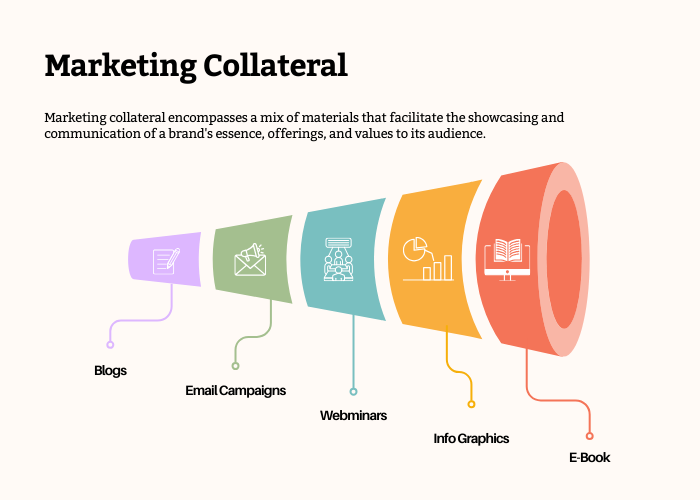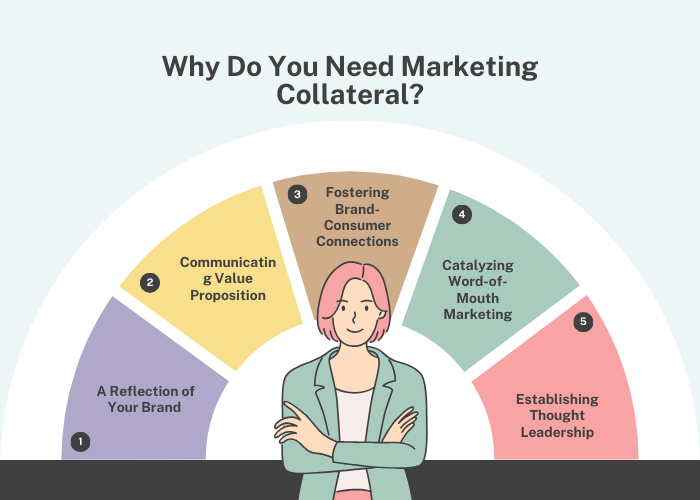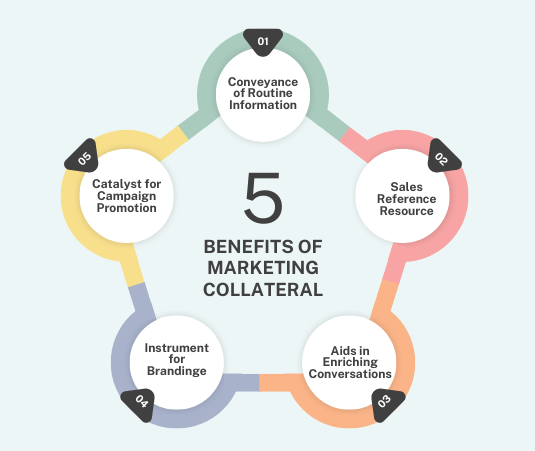While marketing collateral has been used for a long time, it continues to evolve, necessitating frequent reevaluation to be effective. This dynamic character is driven by changing corporate landscapes, new technical breakthroughs, and changing consumer tastes. Adapting to these developments improves how audiences interact with marketing materials and helps organizations optimize their strategic value.
It is an excellent time to refresh our expertise, optimize methods, and examine the advantages of marketing collateral efforts.
Table of Contents
What is Marketing Collateral?

Marketing collateral encompasses a mix of materials that facilitate the showcasing and communicating of a brand’s essence, offerings, and values to its audience. This includes diverse formats: think of intriguing webinars, captivating infographics, and persuasive email campaigns. Marketing collateral supports various objectives, from fostering brand recognition to aiding in customer deliberation and conversion.
Its purpose extends beyond sales; it can bolster internal morale or solidify rebranding efforts. With the digital shift, online resources supplement traditional print media, such as interactive web, landing pages and social media content. Each piece of collateral should educate and engage, pushing your brand to the forefront of consumer consciousness.
Key Takeaways
- Marketing collateral changes with business landscapes, technical developments, and consumer preferences, demanding periodic reevaluation.
- It comprises webinars, infographics, email campaigns, and other marketing tools for reasons other than sales, such as corporate morale and rebranding.
- It reflects your brand’s identity while maintaining engagement with potential clients in both the B2B and B2C sectors.
- Highlights how offerings solve consumer problems and influence purchase decisions.
- Integrates content across media boosts engagement and establishes the company as a market leader.
Why Do You Need Marketing Collateral?
Marketing collateral is crucial to any company’s strategy for engaging with its audience and increasing sales. Understanding why it is necessary can change the way we approach content marketing and campaigns. Here are five main reasons:
1. A Reflection of Your Brand
Whether you work in the B2B or B2C sectors, marketing collateral reflects your brand’s identity.
Given the length of B2B sales cycles and large deal sizes, sales staff rely on various marketing materials to keep existing customers and potential clients engaged throughout the decision-making process. This constant involvement not only fosters but also strengthens client connections over time.
- In the B2C realm, transactions are frequently impulsive or quick. Thus, marketing materials such as testimonials, detailed product descriptions, and visually appealing websites must play an important part in guiding consumers to make a buy.
- Marketing materials are available 24 hours a day, seven days a week, to give potential clients easy access to your company’s information.
- Effective marketing collateral includes a wide range of digital formats such as videos, e-books, instructional websites, engaging social media content, and classic ones such as brochures and flyers.
2. Communicating Value Proposition
Your products or services are designed to meet specific consumer needs and challenges. In this perspective, marketing collateral has two purposes:
- First, it captures potential clients’ interest by emphasizing how your goods can solve their specific problems or meet their wants.
- Second, it encourages potential consumers to purchase by providing instructional content and captivating storytelling.
A local bakery, for example, could use engaging social media posts to showcase the workmanship and natural ingredients used in its bread, emphasizing the value it offers health-conscious consumers.
3. Fostering Brand-Consumer Connections
Marketing collateral goes beyond standard advertising by integrating your brand into your target audience’s daily lives and conversations.
It accomplishes this by seamlessly integrating content from paid and organic sources, promoting engagement in depth and debate about your brand.
Consider developing a fitness app that uses user success stories and interactive challenges to foster a sense of community and bring users closer to the brand.
4. Catalyzing Word-of-Mouth Marketing
In the digital age, referrals from friends, relatives, and even internet reviews far surpass the effectiveness of direct promotion.
Good marketing collateral encourages sharing, whether through a well-crafted blog post or video that goes viral or customers who naturally share their great experiences with your product.
Consider a new eco-friendly cleaning product line widely praised on sustainable living blogs and forums for its efficacy and environmental friendliness, resulting in word-of-mouth promotion.
5. Establishing Thought Leadership
Becoming a thought leader entails more than just being successful in your industry; it also requires sharing knowledge, ideas, and inventions that can inspire and aid others.
Marketing collateral highlighting your company’s expertise, research findings, or technological advances presents your brand as a thought leader in your sector.
Consider a renewable energy firm that frequently releases white papers on the future of energy sustainability or gives interesting TEDx speeches on global energy concerns, establishing itself as a thought leader in the green tech sector.
Benefits of Marketing Collateral
When well-structured and properly designed, marketing collateral provides numerous benefits both within and outside of the firm. Here are five benefits it brings to any business:
1. Conveyance of Routine Information
Every sector contains critical information that clients usually demand, such as product specifications, pricing, or special terms and conditions.
Having such information readily available is more productive than for sales personnel to learn and repeat it each time a client asks for it. For example, a website’s ‘About Us’ landing page itself might be considered marketing content that can be utilized to anticipate client inquiries.
2. Sales Reference Resource
With so many technical nuances to consider, it is frequently best not to rely on sales personnel to remember every detail, especially when a minor difference can have a huge impact on product efficacy.
Providing sales professionals with tools like a technical fact sheet or a sales guide during client meetings may be quite beneficial. These tools can serve as both a dependable reference point and a reminder of the conversation.
3. Aids in Enriching Conversations
Effective collateral should facilitate and improve communication in the absence of a sales professional. It acts as a response medium for general consumer inquiries, allowing consumers to compare different product aspects independently, resulting in a more incisive comparison.
4. Instrument for Branding
Customers engage with good marketing collateral not only once but multiple times. As a result, it is critical that your marketing collateral examples clearly communicates your brand’s identity and distinguishes your values from competitors.
The more potential customers interact with your material, the better they can tie your beliefs to your brand, increasing the likelihood that you will stay their first choice.
5. Catalyst for Campaign Promotion
Marketing material is an essential tool for supporting sales campaigns. It enables organizations to present their products or services by their existing brand identity, resulting in a deeper and more comprehensive grasp of their brand’s personality.
Campaigns, which are well-known for their ability to instill a sense of significance in the context of short-term events, can be boosted even further by creating marketing collateral that engages and captures customer attention.
Types of marketing collateral
Marketing collateral is a collection of media, material, and information used to promote the sale of a product or service. It is an essential component of any effective marketing plan, focusing on traditional and digital platforms.
To convey insights without confusing jargon, this explanation aims to provide a clear and comprehensive overview of the armament accessible to marketers targeting professionals and those pursuing further education in business-related subjects.
Types of marketing collateral include:
- Banner Ads: Simple yet striking web banners that direct viewers towards your offerings with a compelling call to action.
- Blog Posts: Engaging and informative articles aimed at adding value, showcasing expertise, and nurturing customer relationships.
- Brand Magazines: Publications that may range from product-focused catalogs to thematic articles tailored for brand storytelling.
- Brochures: Easily digestible leaflets that combine eye-catching images with brief text to share your brand story.
- Direct Mail: Personalized postal communications that resonate with the recipient’s interests and previous interactions with your brand.
- Displays: Versatile signage solutions such as billboards or point-of-sale materials designed to catch the eye and promote engagement.
- E-books: Deep dives into specific subjects, crafted to educate and entertain, used as a lead magnet or premium content offerings.
- Infographics: Visual narratives that simplify complex data into graphic, easily understood formats.
- Logos: Distinct symbols representing your brand’s essence are vital for immediate recognition.
- Newsletters: A blend of news and insights delivered directly to your audience’s inbox, balancing informational content with subtle promotion.
- Podcasts: Audio programs delivering value through relevant content require thoughtful planning and resource investment to stand out.
- Reports: Deep analyses on research or data that underscore your authority and expertise on a subject.
- Reviews: User-generated endorsements that reflect your brand’s and product experiences’ true impact.
- Sell Sheets: Snapshot documents detailing product features and benefits, enhanced with visuals for quick reference.
- Social Media: Curated platforms chosen based on your target audience to deliver tailored and impactful brand experiences.
- Specialty Items: Thoughtfully chosen branded merchandise that aligns with your brand values and is practical for the recipient.
- Testimonials and Case Studies: Real accounts from customers that underline your offerings’ value proposition and applications.
- Videos: Diverse formats, from instructional content to engaging stories that offer strong ROI and appeal to a broad audience.
- Visual Content: Any marketing piece incorporating visual elements, whether text with added graphics or standalone visuals.
- Webinars are online seminars that may be live or prerecorded. They provide educational content and can be extended into other marketing materials.
- Websites: Your digital storefront, encompassing a wide range of marketing collateral, is a perpetual sales tool.
- White Papers: Detailed guides presenting problem-solving insights and positioning your brand as a thought leader.
- Company Folders: Informational packets that showcase your company’s offerings can include various marketing materials for distribution.
- Calendars: Custom-branded calendars are a subtle daily reminder of your brand and a utility item that keeps your company top of mind.
- Branded Envelopes: Custom envelopes that carry your brand’s identity, creating a memorable and professional impression with every correspondence.
- Business Cards: Tangible connections providing contact details for easy networking and continued communication.
- Vertical/Industry Pages: Tailored web pages highlighting how your products meet unique industry-specific needs.
- Price Lists: Up-to-date compilations of product prices for transparent customer communication, both online and in print.
- List of Partners and Vendors: Demonstrates industry affiliations and partnerships, enhancing brand credibility.
- Biographies of Founders and Executives: Personal stories and achievements of company leadership, fostering trust and humanizing the brand.
This marketing collateral lineup is dynamic and should evolve with your audience’s needs and marketing landscapes. Whether using bullet points or narratives, consistency in branding and clarity of message is key across all forms.
How to create great marketing collateral
Creating exceptional marketing collateral is not just about crafting materials; it’s about telling your story in a way that resonates with your audience and drives your business forward. Considering the insights gathered from various competitors, here’s how you can achieve that goal.
1. Set Clear Objectives and Monitor Them
Understanding what you aim to achieve with your marketing collateral is crucial. Different objectives necessitate different strategies and tools. Whether your primary aim is to boost revenue, enhance brand recognition, or deepen client understanding of your offerings, setting clear objectives is the first step.
- Develop actionable goals: For instance, if broadening the understanding of your offerings is a goal, investing in informative blog posts or creating engaging tutorial videos for platforms like YouTube can be beneficial.
- Identify key performance indicators (KPIs): Decide on the metrics that will indicate success for your campaign. If increasing sales is the aim, focus might be placed on enhancing the user experience of product pages and closely watching conversion rates.
- Track and adapt based on performance: Use tools such as Google Analytics to monitor the performance of your marketing materials. This could involve monitoring the click-through rates of a revamped newsletter and making adjustments based on these insights.
2. Know Your Audience
The success of your marketing efforts hinges on how well you understand your audience. Through strategic research, you can tailor your marketing collateral to optimally meet their needs, values, and preferences.
- Dive deep into analytics: Utilize data from your website and social platforms to discern which content types and messages resonate most with your audience.
- Construct detailed user personas: Crafting detailed profiles of your ideal customers can help guide your marketing materials’ tone, style, and delivery.
- Leverage social media for insights: Participate in and monitor social media conversations and trends relevant to your demographic to gauge their preferences and the kind of marketing collateral that would engage them the most.
3. Ensure Brand Consistency
Maintaining a consistent brand identity across all marketing collateral strengthens brand recognition and fosters trust with your audience. Consistency is key to converting leads into loyal customers.
- Develop a comprehensive brand guide: A detailed style guide or brand book ensures that all marketing materials align with your brand’s identity, from logos and color schemes to the tone of voice used in the text.
- Optimize and reuse effective collateral: Analyze past marketing efforts to identify what has performed well. Adapt and repurpose this content to maintain consistency and reinforce your messaging across different channels.
- Consider partnering with a marketing firm: For businesses looking for consistency and quality across all marketing materials, working with a dedicated marketing agency can ensure that every piece of collateral aligns with your brand’s identity and strategic goals.
By focusing on these strategies, you will ensure that your blog content and marketing collateral effectively supports your business goals and resonates deeply with your target audience, setting the stage for lasting engagement and success.
Conclusion
In conclusion, the realm of marketing collateral is vast and multifaceted, serving as a cornerstone for building brand identity, engaging with target audiences, and driving strategic business outcomes. From leveraging a diverse array of digital and traditional formats to ensuring consistency in brand messaging, the creation and optimization of marketing collateral require a deliberate approach tailored to meet consumers’ evolving preferences and needs.
As businesses navigate the dynamic marketing landscape, the focus must remain on crafting compelling narratives that resonate with audiences, fostering connections that transcend mere transactions. By setting clear objectives, understanding the audience deeply, and maintaining brand consistency, organizations can harness the full potential of marketing collateral to achieve their goals, solidifying their position in the competitive market and paving the way for sustainable growth and success.
Liked this post? Check out the complete series on Marketing

